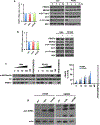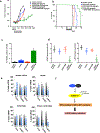The protein arginine methyltransferase PRMT5 confers therapeutic resistance to mTOR inhibition in glioblastoma
- PMID: 31473880
- PMCID: PMC6776692
- DOI: 10.1007/s11060-019-03274-0
The protein arginine methyltransferase PRMT5 confers therapeutic resistance to mTOR inhibition in glioblastoma
Abstract
Introduction: Clinical trials directed at mechanistic target of rapamycin (mTOR) inhibition have yielded disappointing results in glioblastoma (GBM). A major mechanism of resistance involves the activation of a salvage pathway stimulating internal ribosome entry site (IRES)-mediated protein synthesis. PRMT5 activity has been implicated in the enhancement of IRES activity.
Methods: We analyzed the expression and activity of PRMT5 in response to mTOR inhibition in GBM cell lines and short-term patient cultures. To determine whether PRMT5 conferred resistance we used genetic and pharmacological approaches to ablate PRMT5 activity and assessed the effects on in vitro and in vivo sensitivity. Mutational analyses of the requisite IRES-trans-acting factor (ITAF), hnRNP A1 determined whether PRMT5-mediated methylation was necessary for ITAF RNA binding and IRES activity.
Results: PRMT5 activity is stimulated in response to mTOR inhibitors. Knockdown or treatment with a PRMT5 inhibitor blocked IRES activity and sensitizes GBM cells. Ectopic expression of non-methylatable hnRNP A1 mutants demonstrated that methylation of either arginine residues 218 or 225 was sufficient to maintain IRES binding and hnRNP A1-dependent cyclin D1 or c-MYC IRES activity, however a double R218K/R225K mutant was unable to do so. The PRMT5 inhibitor EPZ015666 displayed synergistic anti-GBM effects in vitro and in a xenograft mouse model in combination with PP242.
Conclusions: These results demonstrate that PRMT5 activity is stimulated upon mTOR inhibition in GBM. Our data further support a signaling cascade in which PRMT5-mediated methylation of hnRNP A1 promotes IRES RNA binding and activation of IRES-mediated protein synthesis and resultant mTOR inhibitor resistance.
Keywords: Drug resistance; EPZ015666; Glioblastoma; PP242; PRMT5; Rapamycin; mTOR.
Conflict of interest statement
The authors declare no competing financial interests.
Figures





Similar articles
-
m6A-modification of cyclin D1 and c-myc IRESs in glioblastoma controls ITAF activity and resistance to mTOR inhibition.Cancer Lett. 2023 May 28;562:216178. doi: 10.1016/j.canlet.2023.216178. Epub 2023 Apr 14. Cancer Lett. 2023. PMID: 37061119 Free PMC article.
-
Mechanistic Target of Rapamycin (mTOR) Inhibition Synergizes with Reduced Internal Ribosome Entry Site (IRES)-mediated Translation of Cyclin D1 and c-MYC mRNAs to Treat Glioblastoma.J Biol Chem. 2016 Jul 1;291(27):14146-14159. doi: 10.1074/jbc.M116.726927. Epub 2016 May 11. J Biol Chem. 2016. PMID: 27226604 Free PMC article.
-
Repurposing Potential of Riluzole as an ITAF Inhibitor in mTOR Therapy Resistant Glioblastoma.Int J Mol Sci. 2020 Jan 5;21(1):344. doi: 10.3390/ijms21010344. Int J Mol Sci. 2020. PMID: 31948038 Free PMC article.
-
Role of mTOR in glioblastoma.Gene. 2016 Jan 10;575(2 Pt 1):187-90. doi: 10.1016/j.gene.2015.08.060. Epub 2015 Sep 1. Gene. 2016. PMID: 26341051 Review.
-
Protein arginine methyltransferase 5: a potential cancer therapeutic target.Cell Oncol (Dordr). 2021 Feb;44(1):33-44. doi: 10.1007/s13402-020-00577-7. Epub 2021 Jan 19. Cell Oncol (Dordr). 2021. PMID: 33469838 Review.
Cited by
-
Critical Roles of Protein Arginine Methylation in the Central Nervous System.Mol Neurobiol. 2023 Oct;60(10):6060-6091. doi: 10.1007/s12035-023-03465-x. Epub 2023 Jul 6. Mol Neurobiol. 2023. PMID: 37415067 Review.
-
PRMT5 as a Potential Therapeutic Target in MYC-Amplified Medulloblastoma.Cancers (Basel). 2023 Dec 15;15(24):5855. doi: 10.3390/cancers15245855. Cancers (Basel). 2023. PMID: 38136401 Free PMC article. Review.
-
Oncogenic Smurf1 promotes PTEN wild-type glioblastoma growth by mediating PTEN ubiquitylation.Oncogene. 2020 Sep;39(36):5902-5915. doi: 10.1038/s41388-020-01400-1. Epub 2020 Jul 31. Oncogene. 2020. PMID: 32737433
-
Inhibition of the Protein Arginine Methyltransferase PRMT5 in High-Risk Multiple Myeloma as a Novel Treatment Approach.Front Cell Dev Biol. 2022 Jun 8;10:879057. doi: 10.3389/fcell.2022.879057. eCollection 2022. Front Cell Dev Biol. 2022. PMID: 35757005 Free PMC article.
-
The epigenetic mechanisms involved in the treatment resistance of glioblastoma.Cancer Drug Resist. 2025 Mar 13;8:12. doi: 10.20517/cdr.2024.157. eCollection 2025. Cancer Drug Resist. 2025. PMID: 40201311 Free PMC article. Review.
References
-
- Brennan CW, Verhaak RG, McKenna A, Campos B, Noushmehr H, Salama SR, Zheng S, Chakravarty D, Sanborn JZ, Berman SH, Beroukhim R, Bernard B, Wu CJ, Genovese G, Shmulevich I, Barnholtz-Sloan J, Zou L, Vegesna R, Shukla SA, Ciriello G, Yung WK, Zhang W, Sougnez C, Mikkelsen T, Aldape K, Bigner DD, Van Meir EG, Prados M, Sloan A, Black KL, Eschbacher J, Finocchiaro G, Friedman W, Andrews DW, Guha A, Iacocca M, O’Neill BP, Foltz G, Myers J, Weisenberger DJ, Penny R, Kucherlapati R, Perou CM, Hayes DN, Gibbs R, Marra M, Mills GB, Lander E, Spellman P, Wilson R, Sander C, Weinstein J, Meyerson M, Gabriel S, Laird PW, Haussler D, Getz G, Chin L, Network TR (2013) The somatic genomic landscape of glioblastoma. Cell 155: 462–477 doi:10.1016/j.cell.2013.09.034 - DOI - PMC - PubMed
MeSH terms
Substances
Grants and funding
LinkOut - more resources
Full Text Sources
Molecular Biology Databases
Research Materials
Miscellaneous

